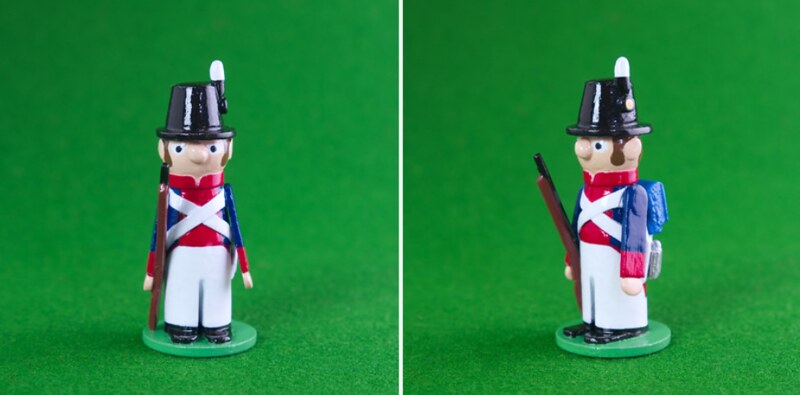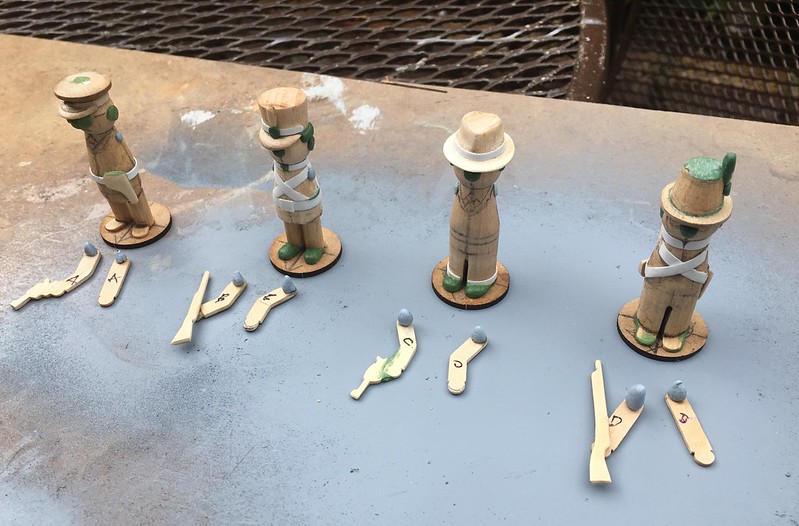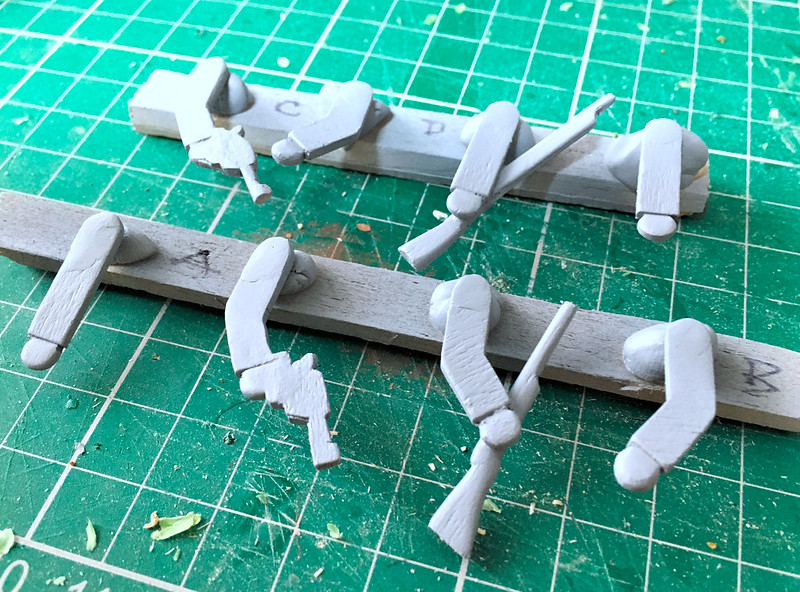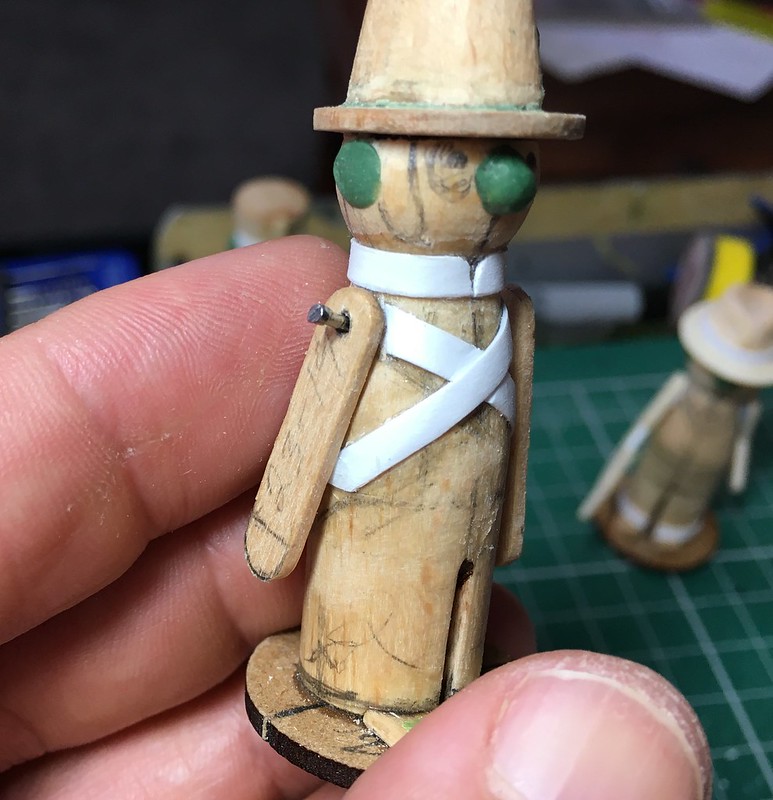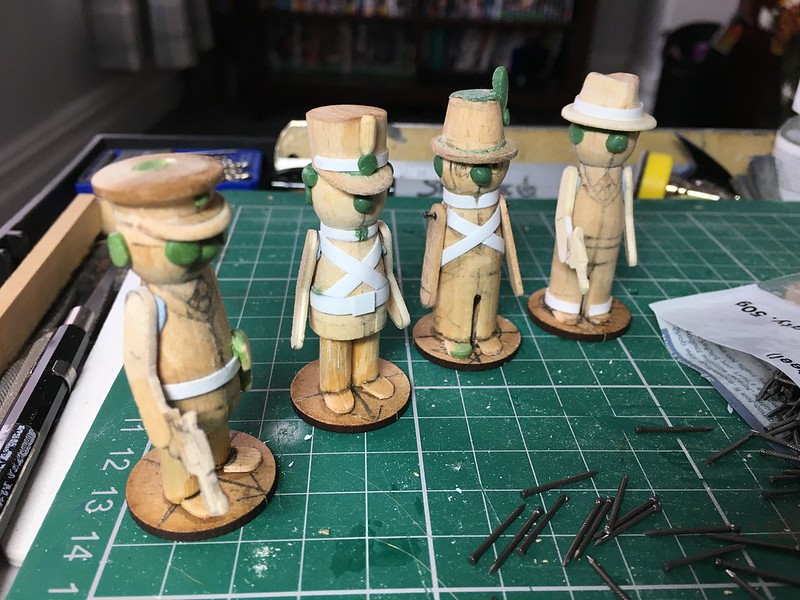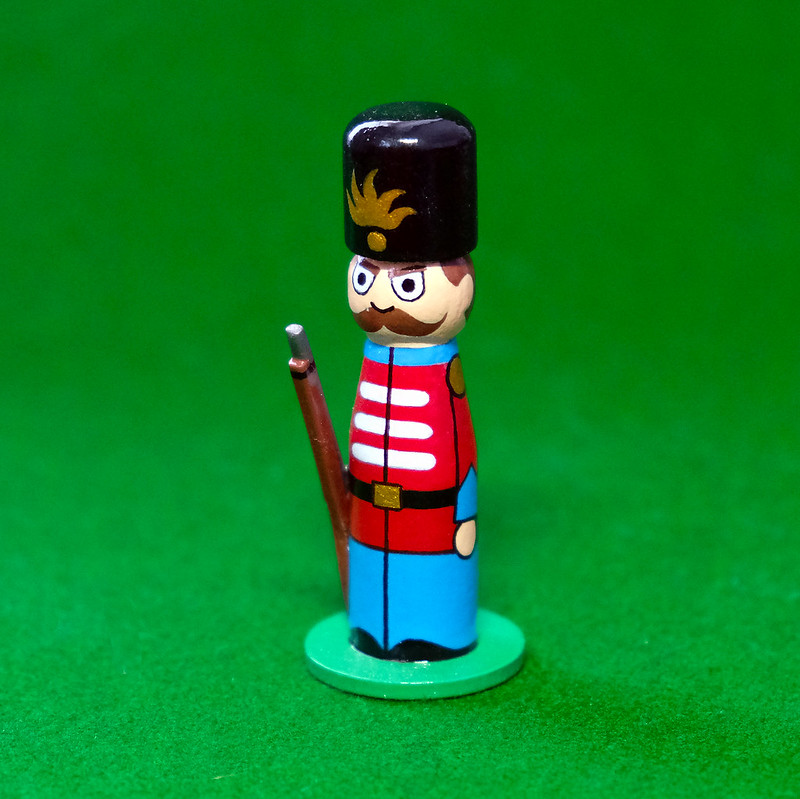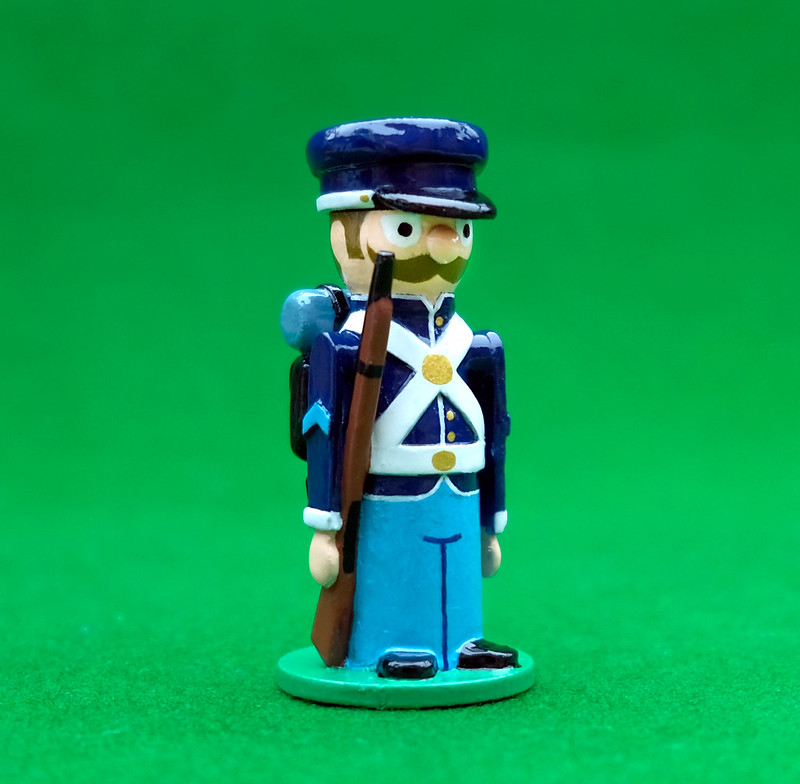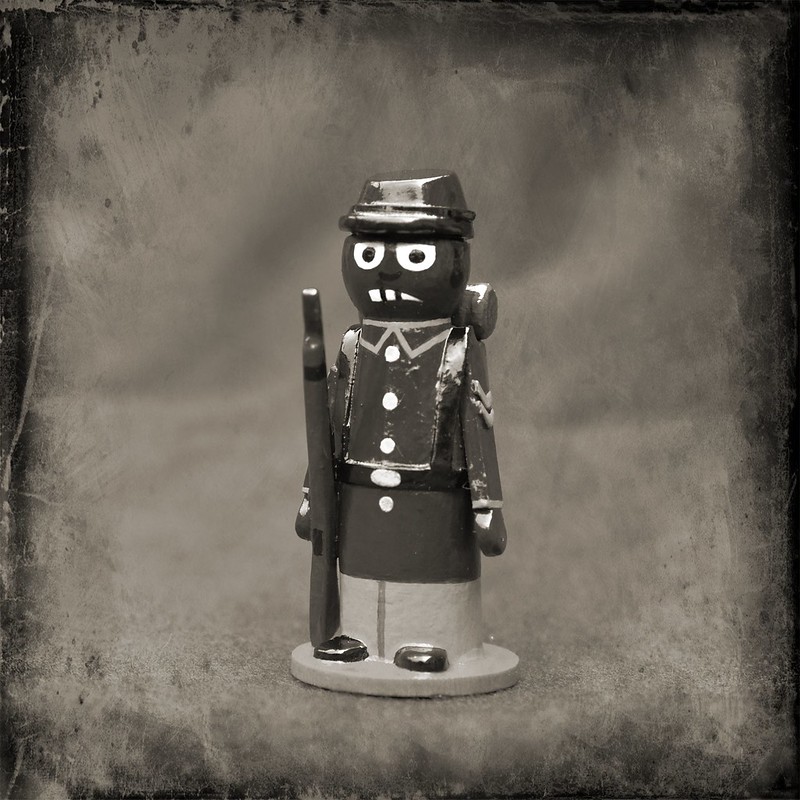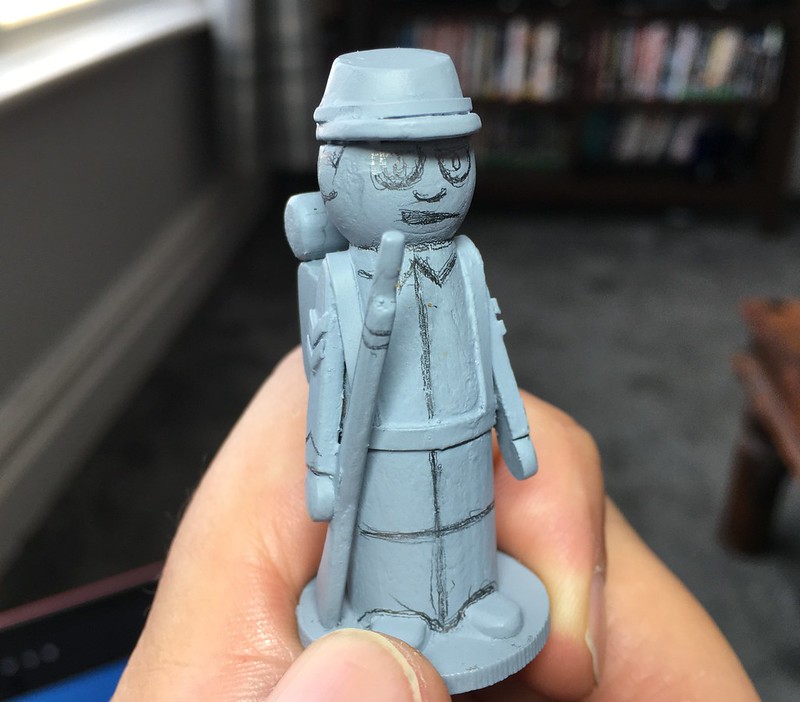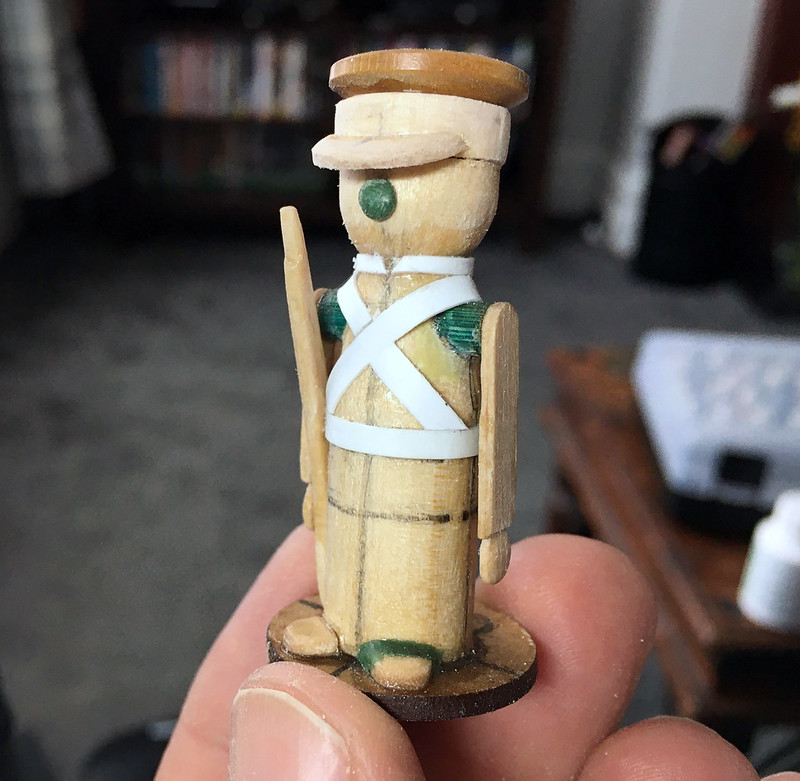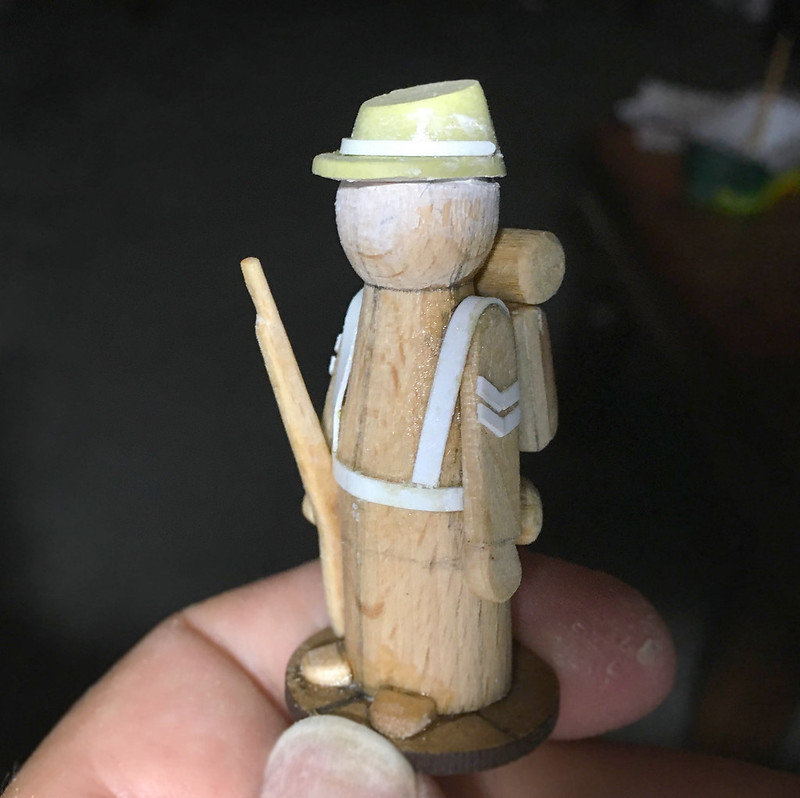I've complete my latest batch of peg figure test models, so I've kinda jumped from the priming phase - covered in my lat post in this series - straight to the finished models in a single bound! Can't say if this is a good of a bad thing - it certainly means there's been a little longer wait between posts though.
However, I did snap one quick photo of the painting process in progress...
I found it quite relaxing to be working on multiple figures in a sort of production line manner, although they were not all identical. It was also very interesting to see how the slight design and construction modifications I had made to each of these test figures worked out as paint was applied. There were very definitely things that worked and things that didn't, but that's why we do tests isn't it? 😄
Anyway, without further ado let's look at the finished models and talk about what I learned from them...
Figure 1: US Militiaman, War of 1812...
Continuing my original intention that any peg figure experimental model would be based on historical US army uniforms (this rule has already been open to bending, as you will see), my first test is a militiaman from the almost forgotten British-American war of 1812 (another win for the Yanks)!
There were a few new ideas I was trying out with this model with a view to simplifying some of the methods I used in my early peg soldiers.
The main thing I tried out was cutting a gap in the lower peg to make separate legs (instead of the simple painted on line I previously used). This may seem a little strange if you consider that I already cut off the dolly peg 'legs' to make this smaller 50mm tall peg doll, but this is a much narrower dividing gap than the original peg pins.
The thinking here is twofold; I find painting a simple line to represent the legs a little tedious (especially if I have several figures to do) and also I wanted to see if an actual physical gap would look more effective (i.e. look better). Believe it or not, it's actually quicker and easier for me to saw this cut while constructing the figure than it is for me to carefully paint on a neat, thin line!
Other new effects used here include the nose! Yep, I'm trying out a cartoon hooter. 😀
This is simply a blob of Milliput modelling putty stuck onto the centre of the face. Again, this is both for quickness (another thing I don't now have to carefully paint or draw on) and to add some three dimensional interest. I'm constantly thinking about the times I have to construct multiple figures in a hurry, small changes like this add up and mean I can produce figures in shorter amounts of time.
And finally, I have opted to use the lolly-stick arms - once
again (sorry) instead of painting on the arms. This make painting a doddle for me as I don't have to expend time carefully outlining 2D features but instead I let 3D add-ons do the work.
Figure 2: 'Perry Mason', 1930s Private Detective...
As well as trying out new construction techniques I also wanted to experiment with some new themes for my models. While I do immensely enjoy making peg soldiers I thought that switching themes might broaden my skill set and keep thinks interesting.
And so... Because I am currently enjoying HBO's 'Perry Mason' reboot so much I really fancied a crack at doing a classic noire hard-boiled detective figure! 😀
As with my 1812 figure I used the divided legs technique, in this case because I wanted my detective to be wearing 1930s style baggy trousers with turn-ups and just painting these on just didn't seem as evocative enough. I needed to model this look.
Next, I went for the lolly-stick style of arms but upped the technique a bit by cutting bent arms out of a thin sheet of wood. Additionally, I tried out adding an object - the revolver - to the component. This posed it's own problems as I ummed and ahhhed about the scale, but in the end, I decided to go for an oversized 'cartoon'
(what fantasy modellers call 'heroic') scale.
And finally, there's the facial features. I am quite happy with the idea of adding a nose in 3D rather than painting one on. While the eyes and mouth (which I now hate) were done in the simplest way I could think of in an attempt at a minimalist look... I don't think I will be doing this again! 😞
Figure 3: Pippin Fort Cadet...
This figure is actually a bit of a joke aimed at myself. When I posted up some photos of my peg figures to a Facebook group one of the comments I received was that my little peeps looked like they belonged in
'Camberwick Green' (you have to be a certain age to understand this critique)!
The classic children's' TV series from the 1960s was popular viewing and aired regularly well into the 1970s (and beyond) and has subsequently gained 'cult' TV status.
Whether it was the googly-eyed cartoon faces of my figures of just the simplified bobble-headed style I don't know, but I though 'what the hell' and for a laugh I decided to go full 'Pippin Fort' with my next peg soldier! But, anyway, the comment tickled me and as I was a fan of the show and so...
The big change here is that I cut down the peg 'body' and added a couple of wooden dowel pieces for the legs. Again, this was to do with the fact that I have become increasingly unhappy with my original method of indicating legs by just painting a line down the middle to indicate the separation.
My simplified shoes also got a make over by using some Milliput putty to create a chunkier boot.
For the facial features I returned to painting in the whites of the eyes, although - as with Camberwick Green - I made the eyes completely circular instead of my normal half-circle shape.
The arms are, once again bent cut-outs, though I chose to make the rifle holding a two-piece component this time. It was just easier (maybe if I had a CNC or MDF laser cutting machine I would have created a one-piece version).
Figure 4: Dad's Army's Captain Manwaring...
Classic TV nostalgia grabbed me and I decided to make another old British small screen character. This was a bit difficult as I am a massive 1960s and 1970s British TV series and so choosing one out of so many characters to model was a real quandary.
So...Which show? Hopefully you'll guess...
Yes? No? ...Well, it's supposed to be Captain Mainwaring from 'Dad's Army'. 😉
I'm not sure if this counts as a caricature as it's only a passing resemblance, but this is the first time I've tried to recreate a specific character.
The major new technique here is the creation of a rounded lower body to which I have attached a couple of dowel legs. A touch of realism for the body...Just. I'm kinda liking the proper legs idea, not because I am trying to make my peg figures 'more realistic' but because it opens up a lot of possibilities for poses AND it's more satisfying than just a painted line.
The spectacles was a surprise 'win' - these would have normally been painted on but adding more appropriate 3D decoration seems to be the way I am going. But not too much!
Summing Up What I Have Learned...
Story short, my peg figures are
not evolving. While I do really like some of the new techniques I've tried out here I still actually like my original way of doing things as well. So, no, this isn't an evolution it's more about finding new ways of doing different types of models for different types of projects. Sometimes my peg soldiers are toys, sometimes they are ornaments. Does that make sense?
I'll modify my techniques depending on what I'm trying to achieve. More detailed for 'caricatures' and my original simplified style for 'trinkets' (I'll elaborate what I mean by trinkets in a later post).
So, what did I like (and not like)?
I liked the dowel legs (for appropriate jobs), they give me the chance to model specific poses and slimmer body types for refined female characters (my original one-piece peg body can look a wee bit plump, especially towards the bottom).
The bent arms (for want of a better name for them) are also nice and open up options for more dynamic poses. To be honest, the painted on arms of my original figures were my least favourite part of my peg soldiers. Not because of their look but because they were a pain to paint on. One of the things I wanted to try out was faster way of creating the figures and I found that laboriously painting a whole unit of arms was a bit tedious!
The method of cutting out the arm with an object in one single piece interests me, I like how streamlined the flat component is. A two-piece equivalent would be a little awkward, I think. Though, I did like having the flat arm and the rifle in two separate bits, go figure. (Horses for courses again.)
Noses... Yes or no? ...Maybe, depending! 😁
I don't think the same fat rounded nose I did (made out of a blob of Milliput, btw) is suitable for
every figure. I mean, what happens if I do a slim character or a female? It just wouldn't look right. So I like the nose idea
in principal but I think I will have to modify the nose shape for specific body types.
Finally, facial features. I definitely didn't like the 'Perry Mason' simplified features (they were bloomin' awful). In fact, this is the one thing that I think I did better the way I originally painted them with the half-circle eyes. But the mouth poses a conundrum, I'm afraid I'll have to do some more tests to find a satisfactory way of doing this.
 |
My original way of doing eyes and the rounded version for my Pippin Fort
cadet. I may just revert to doing my eyes the original way but may do them
slightly smaller. I also liked omitting a mouth, that works well. |
All in all, I've enjoyed this experiment and I have learned a few new tricks. Let's see if I can apply what I've learned to a 'live' project! 😊




